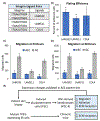Effects of TP63 mutations on keratinocyte adhesion and migration
- PMID: 37432020
- PMCID: PMC10529328
- DOI: 10.1111/exd.14885
Effects of TP63 mutations on keratinocyte adhesion and migration
Abstract
The goal of this study was to investigate the molecular mechanisms responsible for the formation of skin erosions in patients affected by Ankyloblepharon-ectodermal defects-cleft lip/palate syndrome (AEC). This ectodermal dysplasia is caused by mutations in the TP63 gene, which encodes several transcription factors that control epidermal development and homeostasis. We generated induced pluripotent stem cells (iPSC) from AEC patients and corrected the TP63 mutations using genome editing tools. Three pairs of the resulting conisogenic iPSC lines were differentiated into keratinocytes (iPSC-K). We identified a significant downregulation of key components of hemidesmosomes and focal adhesions in AEC iPSC-K compared to their gene-corrected counterparts. Further, we demonstrated reduced AEC iPSC-K migration, suggesting the possibility that a process critical for cutaneous wound healing might be impaired in AEC patients. Next, we generated chimeric mice expressing a TP63-AEC transgene and confirmed a downregulation of these genes in transgene-expressing cells in vivo. Finally, we also observed these abnormalities in AEC patient skin. Our findings suggest that integrin defects in AEC patients might weaken the adhesion of keratinocytes to the basement membrane. We propose that reduced expression of extracellular matrix adhesion receptors, potentially in conjunction with previously identified desmosomal protein defects, contribute to skin erosions in AEC.
Keywords: TP63; ectodermal dysplasia; extracellular matrix adhesion; hemidesmosome; skin erosion.
© 2023 The Authors. Experimental Dermatology published by John Wiley & Sons Ltd.
Conflict of interest statement
Conflict of interest statement:
The authors declare no conflict of interest.
Figures



Update of
-
Effects of TP63 Mutations on Keratinocyte Adhesion and Migration.bioRxiv [Preprint]. 2023 Jun 22:2023.05.04.539104. doi: 10.1101/2023.05.04.539104. bioRxiv. 2023. Update in: Exp Dermatol. 2023 Sep;32(9):1575-1581. doi: 10.1111/exd.14885. PMID: 37205354 Free PMC article. Updated. Preprint.
References
Publication types
MeSH terms
Substances
Supplementary concepts
Grants and funding
LinkOut - more resources
Full Text Sources
Medical

